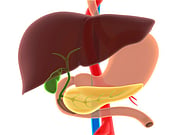
TUESDAY, Feb. 16, 2021 (HealthDay News) -- Most people aren't aware of the signs of gallbladder or bile duct cancer, but the Rutgers Cancer Institute of New Jersey says they should be.
The gallbladder is a small organ connected to the liver by bile ducts. Its job is to store bile, which is made by the liver to aid in digestion of fats.
When cancer develops in the gallbladder, it usually starts in the innermost layers and gradually spreads to surrounding tissues.
That makes it hard to detect early or during a routine physical exam because the gallbladder is tiny and largely hidden by the liver. Fortunately, gallbladder cancer is rare.
Although it usually doesn't cause symptoms until later, sometimes signs do appear, including lumps in the belly, nausea and or vomiting, abdominal pains, weight loss and jaundice.
Bile ducts are thin tubes that move bile from the liver to the small intestine. Bile duct cancer is caused by abnormal growth of cells in any portion of the duct system.
Chronic inflammation of the bile ducts increases the risk of bile duct cancer, as do age and inflammatory bowel disease.
Symptoms of bile duct cancer include jaundice, itching, dark urine, abdominal pain, fever, nausea and vomiting.
Polyps, cysts and other masses can be precursors to these cancers. In these situations, surgery to remove them is a preventative measure.
More information
For more on gallbladder cancer, visit the American Cancer Society.
SOURCE: Rutgers Cancer Institute of New Jersey, news release, Feb. 9, 2021
Back

The news stories provided in Health News and our Health-E News Newsletter are a service of the nationally syndicated HealthDay® news and information company. Stories refer to national trends and breaking health news, and are not necessarily indicative of or always supported by our facility and providers. This information is provided for informational and educational purposes only, and is not intended to be a substitute for medical advice, diagnosis, or treatment.






